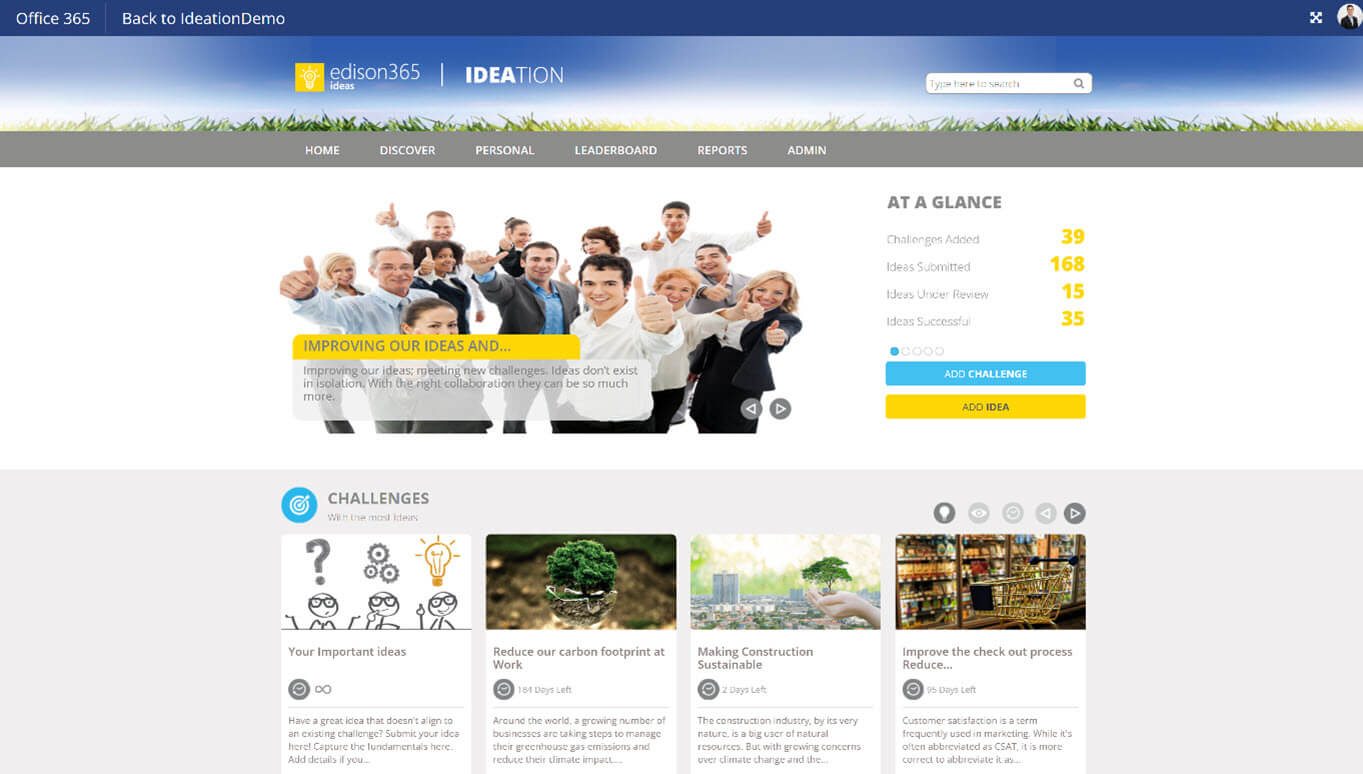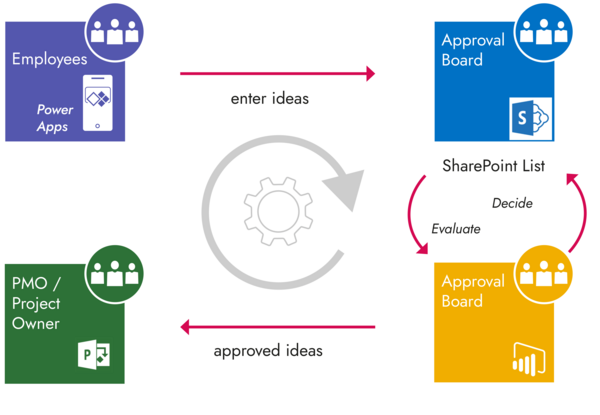Since the 1990s, corporate idea management has been a proven concept for the continuous improvement with employee involvement. It is used to inspire ideas, e.g. for innovation, improvements or cost savings.
However, ideas for improvements within the company have one prerequisite: a company culture characterized by readiness for change as well as collaboration and communication across hierarchies. If your company wants to be successful in this area, this is exactly the right article for you.
In the below chapters, you will learn how to implement idea management.
- What is idea management?
- Why is idea management in companies important?
- Two famous idea management examples
- Challenges of idea management?
- Defining the process
- Winning employees over for idea management
- Defining idea managers as responsible parties
- Using central idea management software
- Conclusion – Implementing idea management in companies
Now, let us begin with the question: what is idea management?
What Is Idea Management?
Idea management (often synonymous with employee suggestion system or suggestion scheme) as a process consists of stimulating, gathering, evaluating and implementing appropriate ideas whose goal is to improve, innovate and save costs for the company. Primarily, it is concerned with internal corporate improvements, such as processes, equipment, etc. In the process, all employees are consulted, some of them actively, and involved and their ideas are incentivized (monetary and / or other incentives).
By contrast, innovation management aims to improve products and services for the market. As a rule, this does not address itself to all staff members. However, these definitions are often not clear-cut or consistent.
Special Download: Resource Planning Software for the Roles Involved (PDF file)
Please fill in the form.
* Required Fields | Data Protection
Why Is Idea Management in Companies Important?
In our fast-paced world, companies with the right ideas at the right time have an important advantage. These “gems of knowledge in the employees’ minds” can be utilized with professional idea management methods.
If your company culture has prepared your staff for the successful gathering and implementation of ideas, you can make use of important idea management benefits. This approach looks at possible improvements not just from the vantage point of top management but also from that of all employees of the company. Thus, the chance for promising ideas and successes is multiplied.
You have to distinguish between hard and soft benefits or factors which can be achieved with idea management methods. The hard idea management benefits / factors are:
- Cost cutting (e.g. by optimizing processes)
- Optimization of the product range
- Quality improvement
- Suggestions for new products
Soft idea management benefits / factors are:
- Growing employee satisfaction (due to appreciation and implementation of their good ideas)
- Retaining employees (by allowing them to contribute to the development of the company)
Two Famous Idea Management Examples
One idea management example is Google. The company considers innovation and creativity driving forces of its success. The idea management culture at Google is characterized by openness, flexibility and a flat hierarchy. Employees are encouraged to contribute their ideas and suggestions, regardless of their position in the company.
Google has developed several platforms and programs for collecting and evaluating ideas. A well-known example is the “20% time program” in which employees can use 20 percent of their working time for projects and ideas of their own. This has led to numerous innovative products.
Another example for idea management is Deutsche Telekom. The telecommunications industry is highly competitive, and Deutsche Telekom has realized that innovation is a key success factor.
The company implemented a comprehensive idea management system involving all employees. The latter are encouraged to submit their ideas via an internal platform on which colleagues can evaluate and discuss them.
Successful idea providers are financially rewarded and receive acclaim for their contributions. In this way, Deutsche Telekom has developed numerous innovative solutions to offer their customers better services and to lower costs.
Both examples show how an open and supportive idea management culture will not only contribute to innovation but also increase employee motivation and engagement.
They serve as good idea management examples illustrating how companies can be successful with idea management in a rapidly changing market environment.
Challenges of Idea Management
Below, you will get to know four key challenges you will need to master when implementing idea management at your company. Yet, the practical tips should allow you to successfully avoid the stumbling blocks.
1. Defining the Process
If you are looking to implement idea management, your first step should be the definition of a suitable idea management process. In this regard, it is important to realize the following: there is no generally valid process – you will have to develop it individually to meet your needs.
It is vital that you work together with the groups concerned to develop a transparent process together and that you live by this process.
In defining the process, falling back on sound know-how and appropriate idea management best practices – also from other companies and industries – can yield positive results. A neutral workshop moderation is one way to achieve this.
In the context of the process, it is also advisable to foster courage to try new things and to test new forms of idea management in small steps.
Our tip: Take enough time to design your idea management process, but do not waste time looking for the absolute optimum. This way, you start sooner. In the event of uncertainties, begin with a smaller process expand it later. This should give you an opportunity for experiments.
2. Winning Employees Over for Idea Management
As with all changes within a company, the new idea generation process will only be successful if the employees accept it and live by it. They need to be able to perceive an advantage for themselves in it. If this is not the case, acceptance among employees and management is at risk.
For instance, it is a problem if the idea providers do not receive feedback on the status of the ideas they submitted, and ideas end up being “lost”. This will lead to a drop in motivation to enter new ideas, and the system can fall into disuse.
At the same time, line managers “blocking” or not admitting ideas pose a threat to idea management. This might have various reasons, e.g.:
- Lack of time
- Failure to recognize the value of an idea
- Lack of skill in handling the ideas
Find out why line managers are central to resource planning in this article.
Another problem for acceptance is a lack of incentives. Therefore, you should ensure that you designate monetary and non-monetary incentives to motivate employees and managers to contribute ideas. In this context, it is important to clearly define the basis for measuring the success of ideas. This will be easier with hard factors, such as the calculation of the ROI, than with soft factors – but it is necessary that the idea provider can measure the value of the idea in a comprehensible way.
What Could a Bonus Scheme Look Like?
The bonus scheme for incentivization is often defined in the company agreement. It is often aligned to the economic value of an idea. Idea providers receive a part of the sum the company saves or earns thanks to the idea. As mentioned above, possibilities include not only monetary but also material rewards, possibly in addition to the monetary ones. Ask yourself the following question: what would motivate the employee concerned?
Campaigns to communicate successful ideas on the intranet, in circular e-mails or at events could add to the motivation of one or two employees who are after public recognition.

Another possibility can be officially announced, playful idea competitions stimulating the ambition and imagination of the staff members. Some providers of idea management tools offer these features.
Reading tip: Learn all about change management in the project environment.
And finally: ensure that management joins in and has capacities and budget in store for idea management.
Our tip: Your best bet for achieving acceptance is to involve both the employees concerned and top management in the development of idea management from the beginning. Rely on targeted change management that accompanies the entire process and keeps communicating the benefits.
3. Defining Idea Managers as Responsible Parties
An essential success factor for your idea management is the clear definition and staffing of the idea manager role.
What is an idea manager?
The idea manager plays a crucial role in organizing, structuring and monitoring the idea management process. This role is the driver of the idea process. In short, it ensures that idea management yields the positive results desired for economic success.
Especially in larger medium-sized companies and in corporations, the idea manager is part of a separate department. In smaller companies, there is often just one person working in this role.
Idea manager responsibilities might be the following:
- Motivating the staff (e.g. by planning and running campaigns and idea competitions on a regular basis)
- Organizing the idea generation process and the idea evaluation (e.g. by enabling a low-threshold recording of ideas with the appropriate tool)
- Ensuring and monitoring a working bonus scheme
- Acting as a contact person for questions and cultivating contact with the decision-makers to enable quick decisions
- Continuous demonstration of the economic benefits of idea management for top management with the aid of KPIs, such as participation rate, average value of ideas, execution rate, etc.
Our tip: Clearly define who has what role and responsibilities in the process of idea management. As the centrally responsible person, the idea manager should monitor this and keep the entire process of idea generation constantly running. Economically, idea management only becomes relevant to the company once the benefits can be measured.
4. Using Central Software
Looking for a suitable idea management tool makes sense only after you have defined the process and the responsibilities. The submission of ideas should be as straightforward as possible for employees. In many cases, ideas do not arise in the workplace but suddenly pop into your head while on holiday, for example. Recording them straightaway needs to be simple.
For your purposes, you should use a standardized and central idea management tool. At a minimum, it should provide the following features:
- Allowing structured recording in ONE user interface on ALL devices (especially mobile ones)
- Evaluation and, if necessary, inquiry for clarification, approval or rejection by the idea manager, for instance
- Detailed description of the idea and development of a concept by the department concerned
- Rejection or approval by the decision-makers with conversion into projects
- Success monitoring to enable possible future improvements in the process
- Archiving of ideas that are currently not relevant to ensure they are not lost and can be used in the future as needed
Not every idea is considered good enough or currently given a high enough priority to allow implementation. In the case of a rejection, make sure the idea providers are notified about the reasons for the decision. This will keep motivation high since the idea is not “lost” from the vantage point of the idea provider.
It would also be good, if the tool enabled the idea provider to see where in the process his or her idea currently was.

Reading tip: PMO Tools for Successful Multi-Project Management
What makes the process of idea management unnecessarily complex and ineffective is not using a centralized idea management software and using the following channels to collect the ideas instead:
- Excel lists
- Telephone
- Post boxes
…
With this “old approach”, you are also going without the collaboration between the employees at the company which is important in the digital transformation.
Our tip: If the topic of collaborative ideas is new to you, look for an experienced service provider. The latter will support you regarding process definition, test system including optimization with a test group as well as change management which may be necessary. This will minimize your risk of failure due to lack of acceptance of the new system.
In the video below, you can watch a chat about What happens when Innovation meets Project Management between TPG’s managing director Thomas Henkelmann and Ivan Lloyd, CEO of edison365.
Conclusion – Implementing Idea Management in Companies
In this article, you have learned that successful idea management in companies is subject to a key prerequisite: you need a company culture characterized by readiness for change as well as collaboration and communication across hierarchies.
The challenges described with many practical tips regarding the approach begin with the initial definition of the idea management process as an important prerequisite for the subsequent steps. Next, it is necessary to win over employees and management for the topic, preferably through continuous change management. The role of the idea manager as the centrally responsible person needs to be defined and filled. In the last step, you must find the right idea management software and implement it step by step
Our final tips
Get to know the individually adaptable “PPM Paradise” – the optimal environment for your enterprise-wide project, program, portfolio and resource management (PPM). Download the free eBook “The PPM Paradise” now (just click, no form).
And sign up for our bi-weekly blog newsletter with information on more practical articles, eBooks, etc. to improve your project management maturity level.
Do you have questions or comments regarding idea management in companies? Please, let us know in a comment below.
Subscribe to TPG BlogInfo: Never miss new practice-oriented tips & tricks
Every other week: Receive practical tips in TPG blog posts written by recognized experts in project, portfolio, and resource management.
* Required Fields | Data Protection
 Johannes Koschinski, PSM I
Johannes Koschinski, PSM I
Head of PPM Consulting, PM Expert
Johannes Koschinski is Microsoft certified senior consultant with a focus on traditional / agile / hybrid project and portfolio management as well as process management based on Microsoft technologies. He addresses topics such as process optimization as well as the development and adaptation of best practice process models. Over the past years, he gained a wealth of practical experience as a trainer and consultant for PPM solutions in different industries. Since 2022, he has been Head of PPM Consulting at TPG.
 Achim Schmidt-Sibeth
Achim Schmidt-Sibeth
Senior Marketing Manager
After earning his engineering degree in environmental technology, he gained many years of experience in project management through his work at an engineering office, an equipment manufacturer, and a multimedia agency. Achim Schmidt-Sibeth and his team have been responsible for content marketing and communication at TPG The Project Group for many years now.







